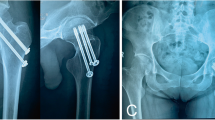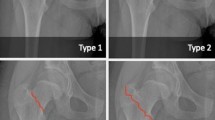Abstract
Introduction
Unicondylar femoral fractures are uncommon injuries, known to occur primarily in young people, with high energy trauma. However, according to our experiences, unicondylar femoral fractures in geriatric patients generally involved the medial femoral condyle, unlike previously reported. In addition, the fractures of medial femoral condyle (FMFC) showed a characteristic fracture pattern. To date, there has been no published article focusing on the FMFC in geriatric patients. Thus, the aim of this study was to determine the characteristics of FMFC in geriatric patients and to present their outcomes.
Materials and methods
We retrospectively reviewed the medical records of 13 patients over age of 65 who underwent surgery for FMFC (AO-OTA 33B2). Of the 13, 10 patients were treated with Tomofix medial distal femoral plate (MDF) (Synthes GmbH, Switzerland) and additional screws fixation; the other three were treated with screw fixation and cast application.
Results
The mean age of patients was 76.8 years, and 10 patients were females. The fracture was due to low-energy trauma in all of the cases. Eight patients had medial knee osteoarthritis, and 2 patients were on osteoporosis treatment. A characteristic fracture pattern was observed. The fracture line extended from the lateral aspect of the intercondylar notch to the posteromedial column of the distal femur, with a characteristic medial beak. All fractures belonged to AO classification 33B2.1; there were no cases of AO classification 33B2.2 or 33B2.3. The postoperative joint function was graded according to the Kolmert functional criteria: ten cases were excellent, one case was good, one case was fair, and one case was poor.
Conclusion
FMFC caused by low-energy trauma in geriatric patients tend to have a characteristic pattern. We believe that anatomic reduction and firm fixation with Tomofix MDF plate and cannulated screw for low-energy trauma FMFC in geriatric patients would yield good outcomes.






Similar content being viewed by others
References
Manfredini M, Gildone A, Ferrante R, Bernasconi S, Massari L (2001) Unicondylar femoral fractures: therapeutic strategy and long-term results. A review of 23 patients. Acta Orthop Belg 67(2):132–138
Ostermann PAW, Neumann K, Ekkernkamp A, Muhr G (1994) Long term results of unicondylar fractures of the femur. J Orthop Trauma 8(2):142–146
Kanoun ML, Chebil M, Ben Maitig M, Ayadi H, Haddad N, Shimi N, Khorbi A, Hachem A (2007) Results of unicondylar femoral fractures: a review of 28 patients. Tunis Med 85(7):586–590
Trillat A, Dejour H, Bost J, Nourissat C (1975) Unicondylar fractures of the femur. Rev Chir Orthop Reparatrice Appar Mot 61(7):611–626
Bel JC, Court C, Cogan A, Chantelot C, Pietu G, Vandenbussche E (2014) Unicondylar fractures of the distal femur. Orthop Traumatol Surg Res (OTSR) 100(8):873–877. https://doi.org/10.1016/j.otsr.2014.10.005
Meinberg EG, Agel J, Roberts CS, Karam MD, Kellam JF (2018) Fracture and dislocation classification compendium-2018. J Orthop Trauma 32(Suppl 1):S1–S170. https://doi.org/10.1097/bot.0000000000001063
Kolmert L, Wulff K (1982) Epidemiology and treatment of distal femoral fractures in adults. Acta Orthop Scand 53(6):957–962
Niikura T, Lee SY, Sakai Y, Nishida K, Kuroda R, Kurosaka M (2015) Retrograde intramedullary nailing for the treatment of femoral medial condyle fracture nonunion. Strategies Trauma Limb Reconst 10(2):117–122. https://doi.org/10.1007/s11751-015-0215-5
Smith EJ, Crichlow TP, Roberts PH (1989) Monocondylar fractures of the femur: a review of 13 patients. Injury 20(6):371–374
Curtis EM, Moon RJ, Harvey NC, Cooper C (2017) The impact of fragility fracture and approaches to osteoporosis risk assessment worldwide. Bone 104:29–38. https://doi.org/10.1016/j.bone.2017.01.024
Rommens PM, Wagner D, Hofmann A (2017) Fragility fractures of the pelvis. JBJS Rev. https://doi.org/10.2106/jbjs.Rvw.16.00057
Kim WY, Lee SW, Kim KW, Kwon SY, Choi YH (2019) Minimally invasive surgical treatment using ‘iliac pillar’ screw for isolated iliac wing fractures in geriatric patients: a new challenge. Eur J Trauma Emerg Surg 45(2):213–219. https://doi.org/10.1007/s00068-018-1046-0
Lee SW, Kim WY, Koh SJ, Kim YY (2017) Posterior locked lateral compression injury of the pelvis in geriatric patients: an infrequent and specific variant of the fragility fracture of pelvis. Arch Orthop Trauma Surg 137(9):1207–1218. https://doi.org/10.1007/s00402-017-2752-5
Rommens PM (2019) Paradigm shift in geriatric fracture treatment. Eur J Trauma Emerg Surg 45(2):181–189. https://doi.org/10.1007/s00068-019-01080-x
Hollensteiner M, Sandriesser S, Bliven E, von Ruden C, Augat P (2019) Biomechanics of osteoporotic fracture fixation. Curr Osteoporos Rep. https://doi.org/10.1007/s11914-019-00535-9
Brinkman JM, Hurschler C, Agneskirchner J, Lobenhoffer P, Castelein RM, van Heerwaarden RJ (2014) Biomechanical testing of distal femur osteotomy plate fixation techniques: the role of simulated physiological loading. J Exp Orthop 1(1):1. https://doi.org/10.1186/s40634-014-0001-1
Acknowledgements
The authors wish to acknowledge the financial support of the Catholic Medical Center Research Foundation program made in the year of 2018.
Author information
Authors and Affiliations
Corresponding author
Ethics declarations
Conflict of interest
The authors declare that they have no conflict of interest.
Ethical approval
Ethical standards and ethical clearance has been taken from the institutional ethical committee.
Additional information
Publisher's Note
Springer Nature remains neutral with regard to jurisdictional claims in published maps and institutional affiliations.
Rights and permissions
About this article
Cite this article
Lee, HH., Kim, WY., Kim, YW. et al. Characteristics of medial condyle sagittal fracture of distal femur involving intercondylar notch in geriatric patients. Arch Orthop Trauma Surg 140, 1687–1693 (2020). https://doi.org/10.1007/s00402-020-03406-6
Received:
Published:
Issue Date:
DOI: https://doi.org/10.1007/s00402-020-03406-6




